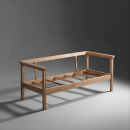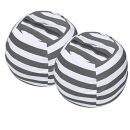
Your leather ottoman adds style and comfort to any room, but keeping it clean can feel tricky. If you want to protect your investment and keep it looking fresh, knowing the right cleaning steps is key.
You’ll discover simple and effective ways to clean your leather ottoman without damaging it. By following these easy tips, you’ll bring back its shine and make it last longer. Ready to see your ottoman looking like new again? Let’s dive in!
Leather Ottoman Basics
Cleaning a leather ottoman requires some basic knowledge about the material. Leather ottomans add style and comfort to any room. They are durable but need proper care to stay beautiful. Understanding the leather type and common problems helps in effective cleaning. This section explains the basics of leather ottomans to help you maintain them well.
Types Of Leather
Leather comes in different types. Each type reacts differently to cleaning methods. Knowing your ottoman’s leather type is important for safe cleaning.
- Full-Grain Leather: The highest quality. It has a natural grain and is very strong. It ages well and develops a nice patina.
- Top-Grain Leather: Slightly processed to remove imperfections. It is smooth and easy to clean, but less breathable than full-grain.
- Genuine Leather: Made from lower layers of the hide. It is less durable and more prone to damage.
- Bonded Leather: Made from leftover leather pieces glued together. It looks like leather but is less durable and can peel.
These types differ in texture, durability, and cleaning needs. For example, full-grain leather cleaning with a damp cloth. Bonded leather may need special cleaners to avoid peeling.
| Leather Type | Durability | Cleaning Ease | Common Use |
|---|---|---|---|
| Full-Grain | High | Easy | Premium furniture |
| Top-Grain | Medium | Moderate | Quality furniture |
| Genuine | Low | Moderate | Budget furniture |
| Bonded | Low | Challenging | Cheap furniture |
Common Stains And Issues
Leather ottomans face different stains and problems. Knowing these helps in quick and safe cleaning.
- Water Spots: Appear as light or dark patches. They happen if water dries on leather.
- Oil and Grease Stains: From hands, food, or lotions. These stains soak in and are hard to remove.
- Ink Marks: Caused by pens or markers. Ink can permanently damage leather if not cleaned fast.
- Scratches and Scuffs: Common with daily use. They make leather look old and worn.
- Fading and Discoloration: Caused by sunlight or harsh chemicals. Fades the leather’s natural color.
Here is a simple guide to recognizing these stains:
| Stain Type | Appearance | Cause | Cleaning Tip |
|---|---|---|---|
| Water Spots | Light or dark patches | Water drying on the surface | Wipe with a soft cloth, condition the leather |
| Oil/Grease | Dark, shiny spots | Skin oils, food, lotions | Blot gently, use leather cleaner |
| Ink Marks | Dark lines or dots | Pen or marker contact | Use rubbing alcohol carefully |
| Scratches | Surface marks, lighter color | Sharp objects, pets | Buff with leather conditioner |
| Fading | Uneven color, pale spots | Sunlight, chemicals | Use leather protectant |
Preparation Steps
Cleaning a leather ottoman starts with careful preparation. These preparation steps help protect the leather and ensure the cleaning works well. Taking time to prepare means the ottoman will look fresh and last longer. Preparation includes gathering the right supplies and testing cleaning products safely.
Gathering Cleaning Supplies
Before cleaning, collect all necessary supplies. Using the right tools makes the job easier and protects the leather from damage.
- Soft cloths: Use microfiber or cotton cloths to avoid scratching the leather.
- Mild soap or leather cleaner: Choose a gentle cleaner made for leather.
- Distilled water: Prevents minerals in tap water from harming the leather.
- Leather conditioner: The leather is soft and prevents cracking after cleaning.
- Vacuum with brush attachment: Gently removes dust and dirt from crevices. gently.
Keep these supplies ready on a clean surface near your ottoman. Organizing everything saves time and avoids interruptions during cleaning.
| Supply | Purpose | Tip |
|---|---|---|
| Soft cloths | Cleaning and wiping | Use separate cloths for cleaning and drying |
| Mild soap or leather cleaner | Remove dirt without damage | Check the label for leather-safe products |
| Distilled water | Mix with soap for cleaning | Prevents mineral spots |
| Leather conditioner | Protect and soften leather | Apply after cleaning |
| Vacuum with a brush | Remove dust | Use low suction to avoid damage |
Testing Cleaning Products
Testing cleaning products prevents damage to your leather ottoman. Some cleaners may change the color or texture of the leather. Always check on a small hidden spot first.
Steps to test products:
- Choose a hidden area like under the ottoman or inside the seam.
- Apply a small amount of cleaner with a soft cloth.
- Wait 10-15 minutes to watch for color change or damage.
- If no change occurs, proceed with cleaning the whole ottoman.
- If color or texture changes, stop using that product immediately.
Keep these tips in mind during testing:
- Test every new product before use.
- Use a minimal cleaner to avoid soaking the leather.
- Do not rub hard; be gentle to avoid scratches.
- Note the results to remember which products work best.
Testing keeps your leather ottoman safe and looking its best. It avoids costly mistakes and keeps the leather’s natural look.
Cleaning Methods
Cleaning a leather ottoman requires specific methods to keep the material soft and lasting longer. Understanding the right cleaning methods helps protect the leather from damage and stains. These methods include dry-cleaning techniques, wet-cleaning solutions, and leather conditioners. Each method plays a key role in maintaining the Ottoman’s look and feel. Knowing how to clean a leather ottoman properly ensures you avoid common mistakes that can ruin the leather.
Dry Cleaning Techniques
Dry cleaning is the safest way to remove dust and loose dirt from a leather ottoman. It prevents the leather from getting too wet, which can cause cracks or discoloration. Use a soft brush or microfiber cloth to wipe the surface.
- Dust regularly: Use a soft cloth once a week to keep dirt from settling.
- Vacuum carefully: Use the soft brush attachment to remove dust from seams and crevices.
- Spot clean with a dry sponge: For small stains, a dry sponge can lift dirt without moisture.
Below is a simple table showing tools for dry cleaning:
| Tool | Purpose | Frequency |
|---|---|---|
| Soft microfiber cloth | Wipe dust and dirt | Weekly |
| Vacuum with brush attachment | Clean seams and crevices | Monthly |
| Dry sponge | Lift small stains | As needed |
Dry cleaning avoids wet spots that cause leather to lose its natural oils. This technique is a good start before cleaning. It is also helpful when learning how to clean a fabric ottoman or how to clean an ottoman with delicate surfaces.
Wet Cleaning Solutions
Wet cleaning helps remove deeper stains and dirt from a leather ottoman. It requires mild products that do not harm the leather. Use a mixture of water and gentle soap or a leather cleaner made for furniture.
Follow these steps:
- Mix warm water with a few drops of mild soap.
- Dampen a soft cloth without soaking it.
- Test the solution on a small hidden area first.
- Gently wipe the leather surface in circular motions.
- Remove excess moisture with a dry cloth.
Important tips for wet cleaning:
- Never soak the leather; too much water causes damage.
- Avoid harsh detergents or bleach.
- Dry the ottoman away from direct sunlight or heat.
Here is a basic recipe for a homemade leather cleaner:
1 cup warm water 1 tablespoon mild liquid soap Mix gently until sudsy Wet cleaning is more active than dry cleaning and removes dirt stuck in pores. It is a key step to learn how to clean a leather ottoman deeply without damaging the material. These methods also help when trying how to clean fabric ottoman or other ottoman types with stubborn stains.
Using Leather Conditioners
Leather conditioners restore moisture and protect the ottoman from cracking. They keep the leather soft and supple. After cleaning, always apply a conditioner to lock in oils and shine.
Follow these guidelines:
- Choose a conditioner made specifically for leather furniture.
- Apply a small amount on a clean cloth.
- Rub it gently into the leather in circular motions.
- Let the ottoman sit for 10-15 minutes to absorb.
- Buff off any excess with a dry cloth.
Conditioners prevent dryness caused by cleaning and sunlight. Use them every 3-6 months, depending on use and climate. A well-conditioned ottoman looks newer and lasts longer.
Here is a simple care schedule for leather ottomans:
| Task | Frequency |
|---|---|
| Dry cleaning (dusting, vacuum) | Weekly to monthly |
| Wet cleaning (soap and water) | Every 3-6 months |
| Leather conditioning | Every 3-6 months |
Knowing how to clean an ottoman properly. It extends the life of your leather ottoman and keeps it looking fresh and soft.
Dealing With Stubborn Stains
Dealing with stubborn stains on a leather ottoman requires care and the right approach. Leather is delicate so harsh chemicals can damage it. Stains like ink, oil, and mold need specific cleaning methods to remove them without harming the leather. Acting quickly and using gentle techniques helps keep your ottoman looking fresh and new. Below are effective ways to handle common tough stains.
Ink And Dye Removal
Ink stains are tricky because they can soak deep into leather. Start by blotting the stain gently with a clean, dry cloth to remove excess ink. Avoid rubbing, which spreads the stain. Use a cotton swab dipped in rubbing alcohol or non-acetone nail polish remover to dab the stain lightly.
- Test the solution on a hidden spot first to check for color loss.
- Apply gently; do not saturate the leather.
- Blot with a dry cloth after dabbing to lift the ink.
If the stain remains, try a leather cleaner made for ink. Follow the instructions carefully. After removal, condition the leather to restore moisture. Never use bleach or harsh chemicals, as they can ruin the leather’s finish.
| Step | Action | Tip |
|---|---|---|
| 1 | Blot excess ink with a dry cloth | Do not rub |
| 2 | Dab with alcohol on a cotton swab | Test on the hidden area first |
| 3 | Blot dry to lift the stain | Repeat if needed |
| 4 | Apply leather conditioner | Restore softness and moisture |
Oil And Grease Stains
Oil and grease stains sit on the surface and can darken leather. Act fast by gently blotting the spot with a paper towel. Avoid spreading the stain. Sprinkle cornstarch or baking soda on the area to absorb the oil. Leave it for several hours or overnight.
- Brush off the powder with a soft brush or cloth.
- If the stain is still visible, use a leather cleaner designed for grease.
- Apply the cleaner with a soft cloth, following product instructions.
- Wipe off any residue and let the leather dry naturally.
Do not use water directly on the stain, as it can spread the grease. Regular conditioning after cleaning helps maintain the leather’s natural oils and shine.
| Material | Purpose |
|---|---|
| Cornstarch or Baking Soda | Absorbs excess oil |
| Leather Cleaner | Removes remaining grease safely |
| Soft Cloth | Applies cleaner and wipes residue |
Mold And Mildew Treatment
Mold and mildew appear as spots or a musty smell on leather. Use a mixture of equal parts water and rubbing alcohol to clean these stains. Dampen a cloth with the solution and wipe the affected area.
- Do not soak the leather; use a light touch.
- Work in a well-ventilated space to help dry.
- After cleaning, dry the ottoman with a soft towel.
For heavy mold, repeat the process or try a commercial leather mold remover. Prevent mold by keeping the ottoman in a dry room and avoiding direct moisture. Use a leather conditioner after cleaning to keep the material flexible and protected.
| Step | Action | Note |
|---|---|---|
| 1 | Mix water and rubbing alcohol (1:1) | Prepare a fresh solution |
| 2 | Wipe mold spots gently | Do not soak leather |
| 3 | Dry with a soft towel | Ensure no moisture remains |
| 4 | Apply leather conditioner | Protect and moisturize |
Maintaining a Leather Ottoman
Keeping a leather ottoman clean and well-maintained extends its life and preserves its beauty. Leather is a durable material, but it needs care to avoid cracks, stains, and fading. Regular maintenance prevents damage and keeps the ottoman looking fresh and inviting. Simple steps like dusting, protecting from harsh elements, and deep cleaning help maintain the leather’s softness and color. Understanding how to care for your leather ottoman ensures it remains a stylish part of your home for years.
Regular Dusting And Wiping
Dust and dirt can accumulate on your leather ottoman, causing surface damage over time. Regular dusting removes particles that could scratch the leather. Use a soft, dry cloth or a microfiber duster to wipe the surface gently at least once a week. This simple step keeps the leather smooth and clean without using any liquid cleaners.
For light wiping, slightly dampen a soft cloth with water. Avoid soaking the leather. Wipe the ottoman gently to remove smudges or spills. Dry the surface immediately with a clean dry cloth.
- Use a soft microfiber cloth for dusting.
- Wipe spills quickly to prevent stains.
- Avoid harsh chemicals or abrasive materials.
- Test any cleaner on a hidden spot first.
Below is a quick guide on dusting and wiping:
| Task | Tools | Frequency | Tips |
|---|---|---|---|
| Dusting | Microfiber cloth or soft duster | Weekly | Use gentle strokes, avoid pressure |
| Light Wiping | Damp soft cloth, dry cloth | As needed | Do not soak leather; dry it immediately |
Protecting From Sun And Heat
Leather is sensitive to direct sunlight and heat sources. Sunlight can fade and dry out leather and causing cracks. Heat from radiators or fireplaces can also damage the leather. Place your ottoman away from windows or heat vents to protect it.
Use these tips to protect your leather ottoman:
- Keep the ottoman out of direct sunlight.
- Use window treatments to block strong sun rays.
- Maintain room temperature and avoid placing near heaters.
- Rotate the ottoman occasionally for even exposure.
Protecting leather from the sun and heat helps keep it soft and prevents color loss. Consider using leather conditioner every few months to restore moisture lost from exposure.
Scheduling Deep Cleaning
Deep cleaning removes built-up dirt and oils that regular wiping cannot. Plan a deep clean for your leather ottoman every 3 to 6 months, depending on use. This maintains the leather’s appearance and prevents damage.
Steps for deep cleaning:
- Vacuum the ottoman using a soft brush attachment to remove dust from seams.
- Apply a leather cleaner with a soft cloth, following product instructions carefully.
- Gently rub the cleaner in circular motions, focusing on stained or dirty areas.
- Wipe off excess cleaner with a clean, damp cloth.
- Allow the leather to air dry naturally.
- Apply a leather conditioner to keep the leather supple and prevent cracking.
Use only products made for leather to avoid damage. Deep cleaning refreshes the leather and extends your ottoman’s life.
Frequently Asked Questions
How Do I Clean A Leather Ottoman Safely?
Use a soft cloth and mild soap mixed with water. Wipe gently to remove dirt. Avoid harsh chemicals that damage leather.
What Products Are Best For Cleaning Leather Ottomans?
Use leather-specific cleaners or mild soap solutions. Avoid abrasive or alcohol-based products. Always test on a small area first.
How Often Should I Clean My Leather Ottoman?
Clean your leather ottoman every 1 to 3 months. Regular cleaning prevents dirt buildup and preserves leather quality.
Can I Use Vinegar To Clean A Leather Ottoman?
No, vinegar is too acidic and can damage leather. Stick to leather-safe cleaners or mild soapy water for best results.
Conclusion
Cleaning your leather ottoman takes just a few simple steps. Use gentle cleaners and soft cloths for the best results. Regular care keeps the leather looking fresh and new. Avoid harsh chemicals that can damage the surface. Dry the ottoman well after cleaning to prevent stains.
A clean ottoman adds style and comfort to any room. These are easy tips to protect your leather ottoman. Small efforts go a long way in leather care. Your ottoman will stay beautiful for years to come.








